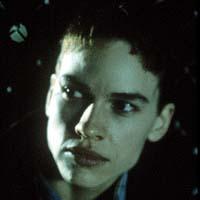 |
Boys
Don't Cry
Director:
Peirce, Kimberly Originally titled Take It Like a Man, Kim Peirce's new feature length film, based upon the story of Brandon Teena, seemed doomed to eat the dust of a Diane Keaton-sponsored venture with the same focus and story line. Keaton's production of the Brandon Teena narrative was rumored to star Drew Barrymore and promised to be a garish Hollywood treatment of this brutal and complex subject matter. But it was Peirce's film, now called Boys Don't Cry, and not Keaton's that made it into production and it is Hilary Swank and not Barrymore whom audiences will watch in the compelling role of Brandon. For all concerned, the fact that Peirce and not Keaton found financing to make a film of the Brandon Teena story is a cause for great celebration. Boys Don't Cry opens with the first of many road shots evoking at once the sense of Nebraska as a wide-open landscape criss-crossed with dusty roads leading from small towns to the middle of nowhere. In one of these small Nebraskan towns, Falls City, the story of Brandon Teena unfolds. As many people know by now, Brandon was a young person born female who chose to live as a male from a fairly early age. Brandon started passing himself off as a man to local girls in Lincoln in his early teens and then moved to Falls City where he developed something of a reputation as a ladies man. Brandon dated several local girls, all of whom later testified that he was a "perfect gentleman" and "the best boyfriend" they ever had. He had a particularly deep relationship with Lana Tisdel and ran afoul of an ex-boyfriend of hers, John Lotter. When rumors began to circulate about Brandon's gender ambiguity, John and his friend, Marvin Thomas Niessen, exposed Brandon to Lana as a woman and then raped him. Three days later, Brandon was found with two other people in a deserted farmhouse shot to death. Lotter and Niessen were arrested and convicted of the three murders. Director Kim Peirce chose to shoot Boys Don't Cry in Texas rather than in Falls City itself, but she captures perfectly the emptiness and boredom of small town middle America where entertainment comes in the form of karaoke, drinking, fighting and, on special occasions, inhaling gas from Redi-Whip cans. While the location for this film was crucial in creating the right feel and mood, casting also presented something of a challenge. Director Peirce interviewed and auditioned hundreds of people for the role of Brandon but was having difficulty finding someone who both looked the part and could act. Peirce commented: "We needed someone who could not only capture Brandon's spirit, but pass as a guy as well as he did." Hilary Swank, formerly known for her TV work in "Buffy the Vampire Slayer," showed up for her audition in a flannel shirt and she hid her long blond hair under a huge cowboy hat. Peirce knew immediately she had found her Brandon. Indeed, Swank is just perfect in the role and she captures the combination of smooth good looks and boyish charm that must have made Brandon so appealing to girls. Similarly, in her role as Lana Tisdel, Chloe Sevigny manages to totally transform herself from the bored and diffident brat that she played in Whit Stillman's The Last Days of Disco into the trashy but cool midwestern girl who falls for Brandon. The acting and casting in Boys Don't Cry is uniformly good and while the film probably runs a little long it remains engaging throughout. Peirce paces well both the flirtation and the sexual interactions between Brandon and Lana, and she does not flinch from either the details of Brandon's gender masquerade (multiple shots of dildos, as well as crotch stuffers and breast binders) or the mechanics of his sexual performance (oral sex and penetration with a dildo). My one criticism of Boys Don't Cry has to do with a weighty omission. When Brandon was executed by Lotter and Niessen, two other people were shot along with him: his friend, Lisa Lambert and Lisa's sister's boyfriend, a disabled African American man named Philip DeVine. Lisa appears in the film as Candace (Alicia Goranson) but Philip DeVine is nowhere to be found. At the end of the film, credits update us on Lana, Lotter and Niessen and they note the deaths of Lisa and Brandon but Philip is simply not mentioned. Obviously, Peirce probably thought that her film, already running close to two hours, could not handle another subplot, but the story of Philip DeVine is important and it is a crucial part of the puzzle of gender, race, sexuality and class that played itself out in the heartland. Race is not incidental to this narrative of mostly white midwestern small towns and Niessen for one was known to be a member of a white supremacist group. By omitting DeVine's story from Boys Don't Cry, Peirce contributes to the detachment of transgender narratives from narratives about race and consigns the memory of DeVine to oblivion. Nonetheless, Boys Don't Cry is an important and brave film. This poignant memorial to the memory of Brandon Teena reminds us how great queer independent film can be if people only have the foresight and the courage to fund it. --Judith Halberstam, Girlfriends Magazine Source : Obtained from PlanetOut.com |